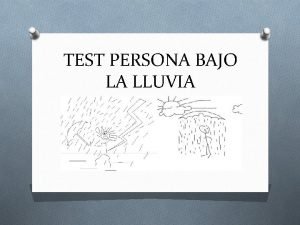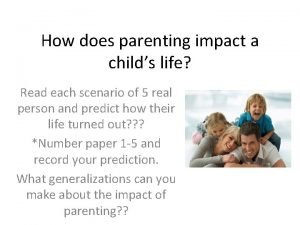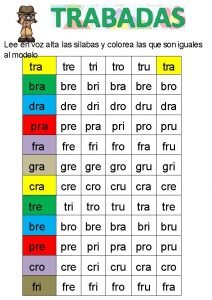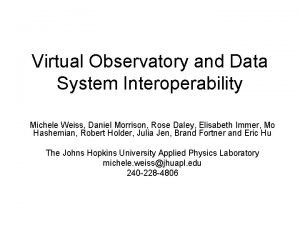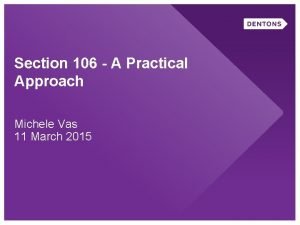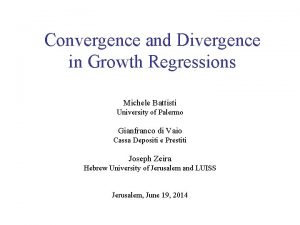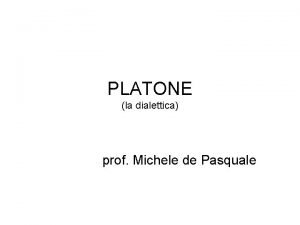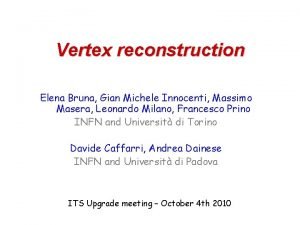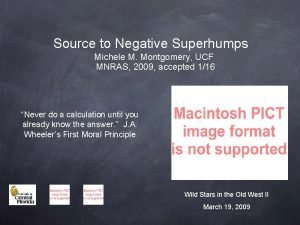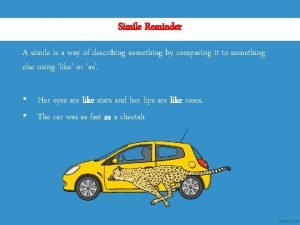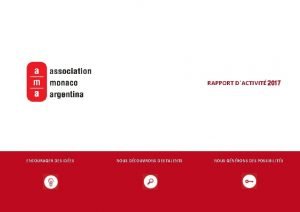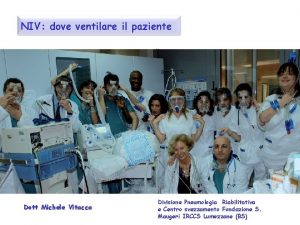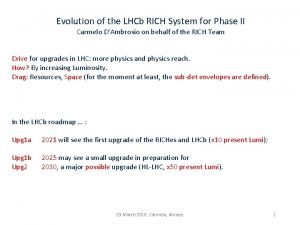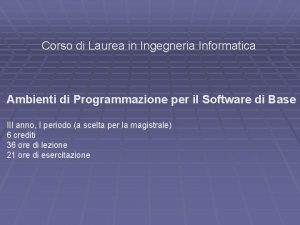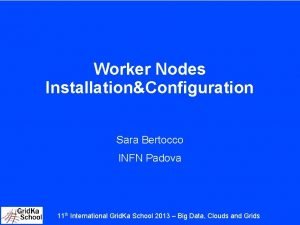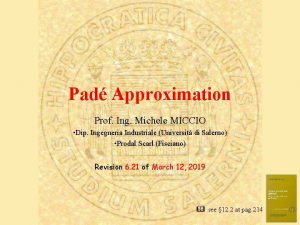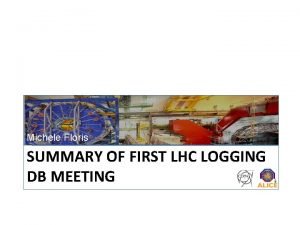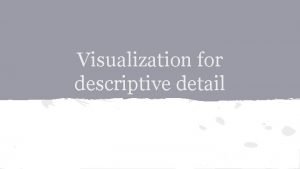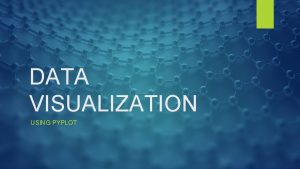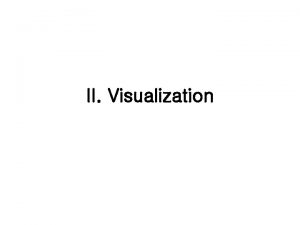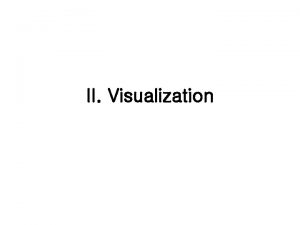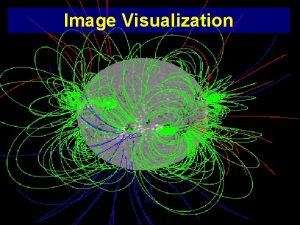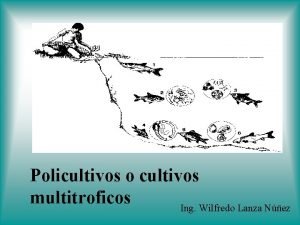Software Visualization Michele Lanza Software Visualization Outline q





























































- Slides: 61

Software Visualization Michele Lanza

Software Visualization - Outline q q q Introduction Software Visualization in a Reengineering Context Static Code Visualization q q Dynamic Code Visualization q q Examples Lightweight Approaches q q q Examples Combining Metrics and Visualization Demonstration Conclusion 2

Prologue q q q Once upon a time… Reverse engineer 1. 2 MLOC C++ system of ca. 2300 classes * 2 = 2’ 400’ 000 seconds / 3600 = 667 hours / 8 = 83 days / 5 = 16 weeks & 3 days ~ 4 months to read the system Questions: q q q What is the size and the overall structure of the system? What is the internal structure of the system and its elements? How did the software system become like that? 3

Introduction q Visualization q q Information Visualization Software Visualization q q Algorithm Visualization Program Visualization • Static Code Visualization • Dynamic Code Visualization q The overall goal is to reduce complexity 4

Information Visualization q q q The human eye and brain interpret visual information in order to “react to the world” We want to answer questions on what we perceive J. Bertin inferred three levels of questions q q Lower perception (one element) Medium perception (several elements) Upper perception (all elements/the complete picture) Information Visualization is about q q how to display information how to reduce its complexity 5

Software Visualization “Software Visualization is the use of the crafts of typography, graphic design, animation, and cinematography with modern human-computer interaction and computer graphics technology to facilitate both the human understanding and effective use of computer software. ” Price, Baecker and Small, “Introduction to Software Visualization” q 2 main fields: q q Algorithm Visualization Program Visualization 6

Conceptual Problem "Software is intangible, having no physical shape or size. Software visualization tools use graphical techniques to make software visible by displaying programs, program artifacts and program behavior. ” [Thomas Ball] 7

Software Visualization in Context q There are many good-looking visualization techniques, but. . when it comes to software maintenance & evolution, there are several problems: q q q Scalability Information Retrieval What to visualize How to visualize Reengineering context constraints • Limited time • Limited resources 8

The Reengineering Life-cycle (0) requirement analysis Requirements (2) problem detection Designs (1) model capture (3) problem resolution (2) problem detection issues • Tool support • Scalability • Efficiency Code (4) program transformation 9

Program Visualization “Program visualization is the visualization of the actual program code or data structures in either static or dynamic form” [Price, Baecker and Small] q q Static code visualization Dynamic code visualization Generate different views of a system and infer knowledge based on the views Complex problem domain (current research area) q q Efficient space use, edge crossing problem, layout problem, focus, HCI issues, GUI issues, … Lack of conventions (colors, symbols, interpretation, …) 10

Program Visualization II q Level of granularity? q q When to apply? q q Complete systems, subsystems, modules, classes, hierarchies, . . . First contact with an unknown system Known/unknown parts? Forward engineering? Methodology? 11

Static Code Visualization q q The Visualization of information that can be extracted from the static structure of a software system Depends on the programming language and paradigm: q Object-Oriented PL: • classes, methods, attributes, inheritance, … q Procedural PL: • procedures, invocations, … q Functional PL: • functions, function calls, … 12

Example 1: Class Hierarchies q q q Jun/Open. GL The Smalltalk Class Hierarchy Problems: q q q Colors are meaningless Visual Overload Navigation 13

Example 2: Tree Maps q Pros q q Cons q q q 100% screen Large data Scales well Boundaries Cluttered display Interpretation Leaves only Useful for the display of Hard Disks 14

Examples 3 & 4 q Euclidean cones q q q Pros: • More info than 2 D Cons: • Lack of depth • Navigation Hyperbolic trees q q Pros: • Good focus • Dynamic Cons: • Copyright 15

Class Diagram Approaches q q For example UML diagrams… Pros: q q q OO Concepts Good for small parts Cons: q q Lack of scalability Require tool support Requires mapping rules to reduce noise Preconceived views 16

Class Diagram Examples 17

Example 5: Metric. View q UML & 3 D 18

Example 6 a: Rigi q q q Scalability problem Entity. Relationship visualization Problems: q q Filtering Navigation 19

Example 6 b: Rigi q q Entities can be grouped Pros: q q q Scales well Applicable in other domains Cons: q Not enough code semantics 20

Evaluation q Pros q q q Intuitive approaches Aesthetically pleasing results Cons q q q Several approaches are orthogonal to each other Too easy to produce meaningless results Scaling up is sometimes possible, but at the expense of semantics 21

Dynamic Code Visualization q Visualization of dynamic behavior of a software system q q Code instrumentation Trace collection Trace evaluation What to visualize • Execution trace • Memory consumption • Object interaction • … 22

Example 1: JInsight q Visualization of execution trace 23

Example 2: Inter-class call matrix q q q Simple Scales quite well Reproducible 24

Example 3: Trace. Crawler 25

Dynamic SV: Evaluation q Code instrumentation problem q q Scalability problem q q Scenario driven Pros: q q Traces quickly become very big Completeness problem q q Logging, Extended VMs, Method Wrapping Good for fine-tuning, problem detection Cons: q q Tool support crucial Lack of abstraction without tool support 26

Taking a step back… q q Why is visualization important at all? Is it actually useful? q q q No, visualization is only a means, not the end… Yes, visualization is only a means, not the end!!! The question is: “What is the end? ” q We want to understand systems… 27

Lightweight Approaches q Already existing approaches and tools exist: q q q hyperbolic views, fish-eye views, spring layouts, … Rigi, Shrimp. View, Creole, Gsee, … Some of them are even copyrighted and/or commercial tools! q Why are they not widely used? q The reengineering context does not permit heavy-weight approaches q Let’s do it lightweight then… 28

Object-Oriented Reverse Engineering q Goal: take a (large legacy) software system and “understand” it, i. e. , construct a mental model of the system ? q Problem: the software system in question is q q Unknown, very large, and complex Domain- and language-specific Seldom documented or commented “In bad shape” 29

Object-Oriented Reverse Engineering (II) q q Constructing a mental model requires information about the system: q Top-down approaches q Bottom-up approaches q Mixed Approaches There is no “silver bullet” methodology Every reverse engineering situation is unique Need for flexibility, customizability, scalability, and simplicity 30

Reverse Engineering Approaches q q Reading (source code, documentation, UML diagrams, comments) Running the SW and analyze its execution trace Interview users and developers (if available) Clustering q q q q Concept Analysis Software Visualization Software Metrics Slicing and Dicing Querying (Database) Data Mining Logic Reasoning … 31

The “Information Crystallization” Problem q Many approaches generate too much or not enough information q The reverse engineer must make sense of this information by himself q We need the right information at the right time 32

What is the actual problem? q q The information needed to reverse engineer a legacy software system resides at various levels We need to obtain and combine q q q Coarse-grained information about the whole system Fine-grained information about specific parts Evolutionary information about the past of the system 33

A simple Solution - The Polymetric View q A lightweight combination of two approaches: q q Software visualization (reduction of complexity, intuitive) Software metrics (scalability, assessment) Interactivity (iterative process, silver bullet impossible) Does not replace other techniques, it complements them: q “Opportunistic code reading” 34

The Polymetric View - Principles q Visualize software: q q q entities as rectangles relationships as edges Enrich these visualizations: q q Map up to 5 software metrics on a 2 D figure Map other kinds of semantic information on nominal colors Entities Relationships width metric 2 position metrics color metric height metric 35

The Polymetric View - Example System Complexity View Nodes = Classes Edges = Inheritance Relationships Width = Number of Attributes Height = Number of Methods Color = Number of Lines of 36

The Polymetric View - Example (II) System Complexity View Nodes = Classes Edges = Inheritance Relationshi ps Width = Height = Color = code # attributes # methods # lines of Reverse engineering goals View-supported tasks • Get an impression (build a first raw mental model) of the system, know the size, structure, and complexity of the system in terms of classes and inheritance hierarchies • Locate important (domain model) hierarchies, see if there any deep, nested hierarchies • Locate large classes (standalone, within inheritance hierarchy), locate stateful classes and classes with behaviour • Count the classes, look at the displayed nodes, count the hierarchies • Search for node hierarchies, look at the size and shape of hierarchies, examine the structure of hierarchies • Search big nodes, note their position, look for tall nodes, look for wide nodes, look for dark nodes, compare their size and shape, “read” their name => opportunistic code reading 37

The Polymetric View - Description q Every polymetric view is described according to a common pattern q Every view targets specific reverse engineering goals q The polymetric views are implemented in Code. Crawler System Complexity View Structural Specification Target. . . Scope. . Metrics. . . . . Layout. . . Description. . . . . Goals ……………………. . ……………… Symptoms …………. . ……………… Scenario Case Study ……………………. . 38

Coarse-grained Software Visualization q Reverse engineering question: q q What is the size and the overall structure of the system? Coarse-grained reverse engineering goals: q q q Gain an overview in terms of size, complexity, and structure Asses the overall quality of the system Locate and understand important (domain model) hierarchies Identify large classes, exceptional methods, dead code, etc. … 39

Coarse-grained Polymetric Views - Example LOC NOS Method Efficiency Correlation View Nodes: Methods Edges: Size: Number of method parameters Position X: Number of lines of code Position Y: Number of statements Goals: • Detect overly long methods • Detect “dead” code • Detect badly formatted methods • Get an impression of the system in terms of coding style • Know the size of the system in # methods 40

Inheritance Classification View Boxes: Edges: Width: Height: Color: Classes Inheritance Number of Methods Added Number of Methods Overridden Number of Method Extended 41

Data Storage Class Detection View Boxes: Width: Height: Color: Classes Number of Methods Lines of Code 42

Quiz: Where would you start looking? Nodes: Edges: Width: Height: Color: Classes Inheritance Relationships Number of attributes Number of methods Number of lines of code 43

Code. Crawler Demo 44

Clustering the Polymetric Views First Contact Candidate Detection System Hotspots System Complexity Root Class Detection Implementation Weight Distribution Data Storage Class Detection Method Efficiency Correlation Direct Attribute Access View Method Length Distribution Inheritance Assessment Class Internal Inheritance Classification Inheritance Carrier Intermediate Abstract The Class Blueprint 45

Coarse-grained SV - Conclusions q Benefits q Views are customizable (context…) and easily modifiable q Simple approach, yet powerful q Scalability q Limits q Visual language must be learned 46

Granularity level problem: It looks nice, but. . . what’s inside? 47

Fine-grained Software Visualization q Reverse engineering question: q q What is the internal structure of the system and its elements? Fine-grained reverse engineering goals: q q q Understand the internal implementation of classes and class hierarchies Detect coding patterns and inconsistencies Understand class/subclass roles Identify key methods in a class … 48

The Class Blueprint - Principles Initialization External Interface Internal Implementation Accessor Attribute Invocation Sequence • The class is divided into 5 layers • Nodes • Methods, Attributes, Classes • Edges • The method nodes are positioned according to • Layer • Invocation sequence • Invocation, Access, Inheritance 49

The Class Blueprint - Principles (II) # invocations Method # lines # external accesses Attribute # internal accesses Abstract Method Constant Method Overriding Method Read Accessor Delegating Method Write Accessor Extending Method Attribute Method Invocation Direct Attribute Access 50

The Class Blueprint - Example q Delegate: q q q Large Implementation: q q q Delegates functionality to other classes May act as a “Façade” (DP) Deep invocation structure Several methods High decomposition Wide Interface Direct Access Sharing Entries 51

The Class Blueprint - Example (II) q Call-flow q q q Inheritance q q q Adder Interface overriders Semantics q q Double Single Entry (=> split class? ) Direct Access State Usage q Sharing Entries 52

Class Blueprint: Data Storage q q q Has many attributes May have many accessor methods No complex behavior q No internal implementation! 53

Class Blueprint: Inheritance Policy Breach 54

The Class Blueprint - A Pattern Language? q The patterns reveal information about q q q Coding style Coding policies Particularities q q We grouped them according to q q q Size Layer distribution Semantics Call-flow State usage Moreover… q Inheritance Context Frequent pattern combinations Rare pattern combinations They are all part of a pattern language 55

The Class Blueprint - What do we see? 56

Code. Crawler Demo 57

Fine-grained SV - Conclusions q Benefits q q Complexity reduction Visual code inspection technique Complements the coarse-grained views Limits q q q Visual language must be learned Good object-oriented knowledge required No information about actual functionality => opportunistic code reading necessary 58

Epilogue q q …happily everafter. Did we succeed after all? Not completely, but… q q System Hotspots View on 1. 200’ 000 LOC of C++ System Complexity View on ca. 200 classes of C++ 59

Industrial Validation - The Acid Test q q q Several large, industrial case studies (NDA) Different implementation languages Severe time constraints System Language Z C++ Y Lines of Code Classes 1’ 200’ 000 ~2300 C++/Java 120’ 000 ~400 X Smalltalk 600’ 000 ~2500 W COBOL 40’ 000 - Sortie C/C++ 28’ 000 ~70 Duploc Smalltalk 32’ 000 ~230 Jun Smalltalk 135’ 000 ~700 60

Software Visualization: Conclusions q q q SV is very useful when used correctly An integrated approach is needed, just having nice pictures is not enough Most tools still at prototype level In general: only people that know what they see can react on that: SV is for expert/advanced developers The future of software development is coming…and SV is part of it 61
 Gaetano antonio lanza curriculum
Gaetano antonio lanza curriculum Adam lanza
Adam lanza Passione mario lanza
Passione mario lanza Serena lanza
Serena lanza Objetivo del test bajo la lluvia
Objetivo del test bajo la lluvia Palazzo lanza bucceri
Palazzo lanza bucceri Ian lanza
Ian lanza Adam lanza
Adam lanza Adam lanza
Adam lanza Algrate
Algrate Lanza gritos de alegria letra
Lanza gritos de alegria letra Lanza termica para corte
Lanza termica para corte Silabas pra pre pri pro pru
Silabas pra pre pri pro pru Operacion lanza de neptuno
Operacion lanza de neptuno Desde una altura de 60m se lanza verticalmente hacia arriba
Desde una altura de 60m se lanza verticalmente hacia arriba What is a quote sandwich
What is a quote sandwich Michele weiss
Michele weiss Michele amorena
Michele amorena Michele pianigiani
Michele pianigiani Michele vas
Michele vas Michele cirelli
Michele cirelli Michele doro
Michele doro Michele banko
Michele banko Pas bien dans sa vie
Pas bien dans sa vie Michele giorgione
Michele giorgione Scarponi michele
Scarponi michele Michele curioni
Michele curioni Michele battisti
Michele battisti Fisiopatologia respiratoria brescia
Fisiopatologia respiratoria brescia Michele kito
Michele kito Michele de pasquale
Michele de pasquale Michele kahane
Michele kahane Michele gubian
Michele gubian Michele jacobsen
Michele jacobsen Michele chaban
Michele chaban Michele hugin
Michele hugin Michele pestalozzi
Michele pestalozzi Michele innocenti
Michele innocenti Michele marie montgomery
Michele marie montgomery As bleak as simile
As bleak as simile Michele rubinelli monaco
Michele rubinelli monaco Isabella savella
Isabella savella Michele vitacca model
Michele vitacca model Cornell dining nutrition
Cornell dining nutrition Michele travi arezzo
Michele travi arezzo Nodal surface
Nodal surface Clarestorio
Clarestorio Michele thomas
Michele thomas Michele green design
Michele green design Benzopironi
Benzopironi What is mslbe
What is mslbe Michele blago
Michele blago Dottor prencipe
Dottor prencipe Michele partipilo
Michele partipilo Michele ianni unical
Michele ianni unical Michele bertocco
Michele bertocco Michele obama
Michele obama Michele colucci
Michele colucci Gennaro autuori e michele del giudice
Gennaro autuori e michele del giudice Michele miccio
Michele miccio Michele grisanti
Michele grisanti Michele floris
Michele floris




